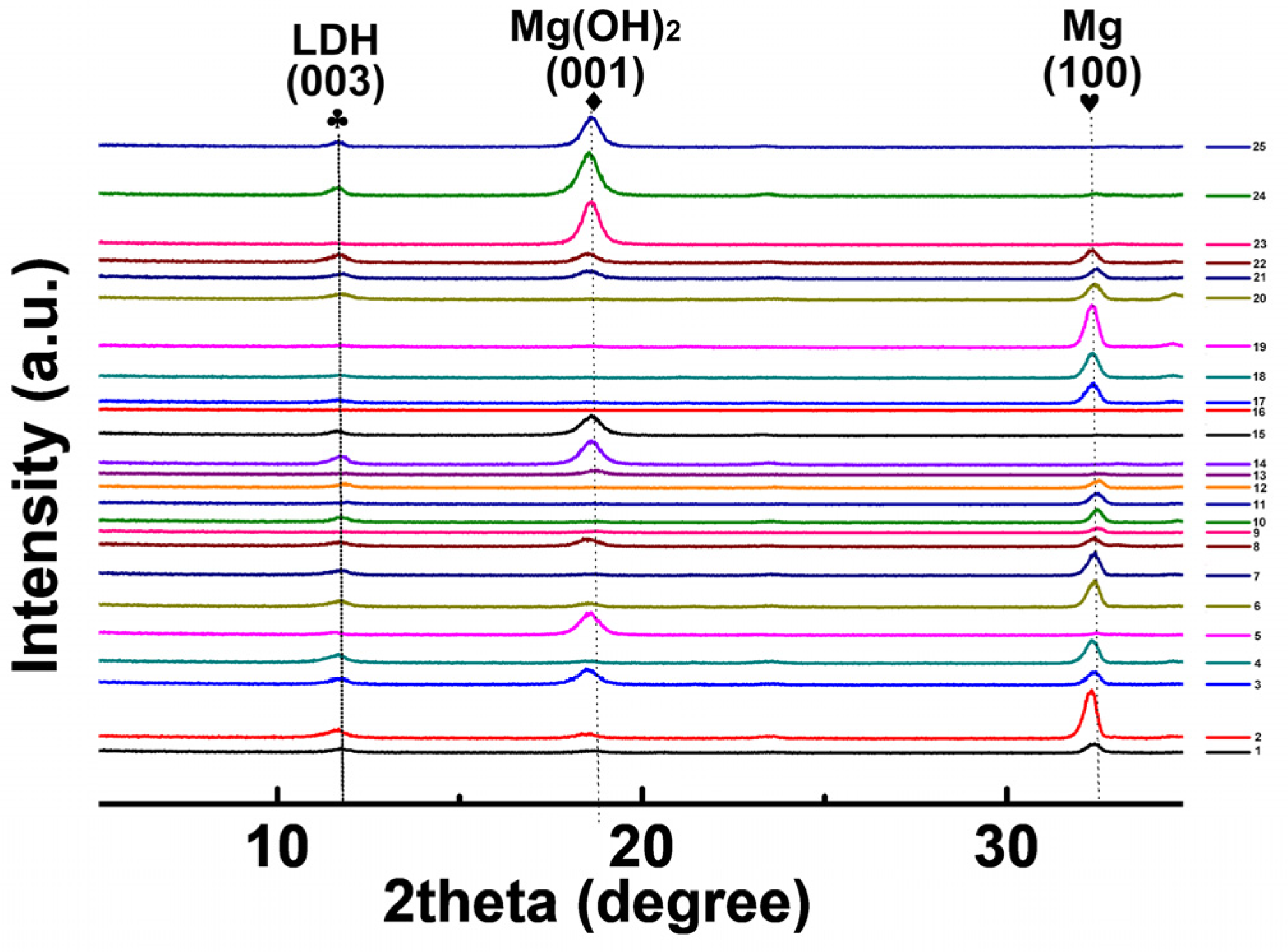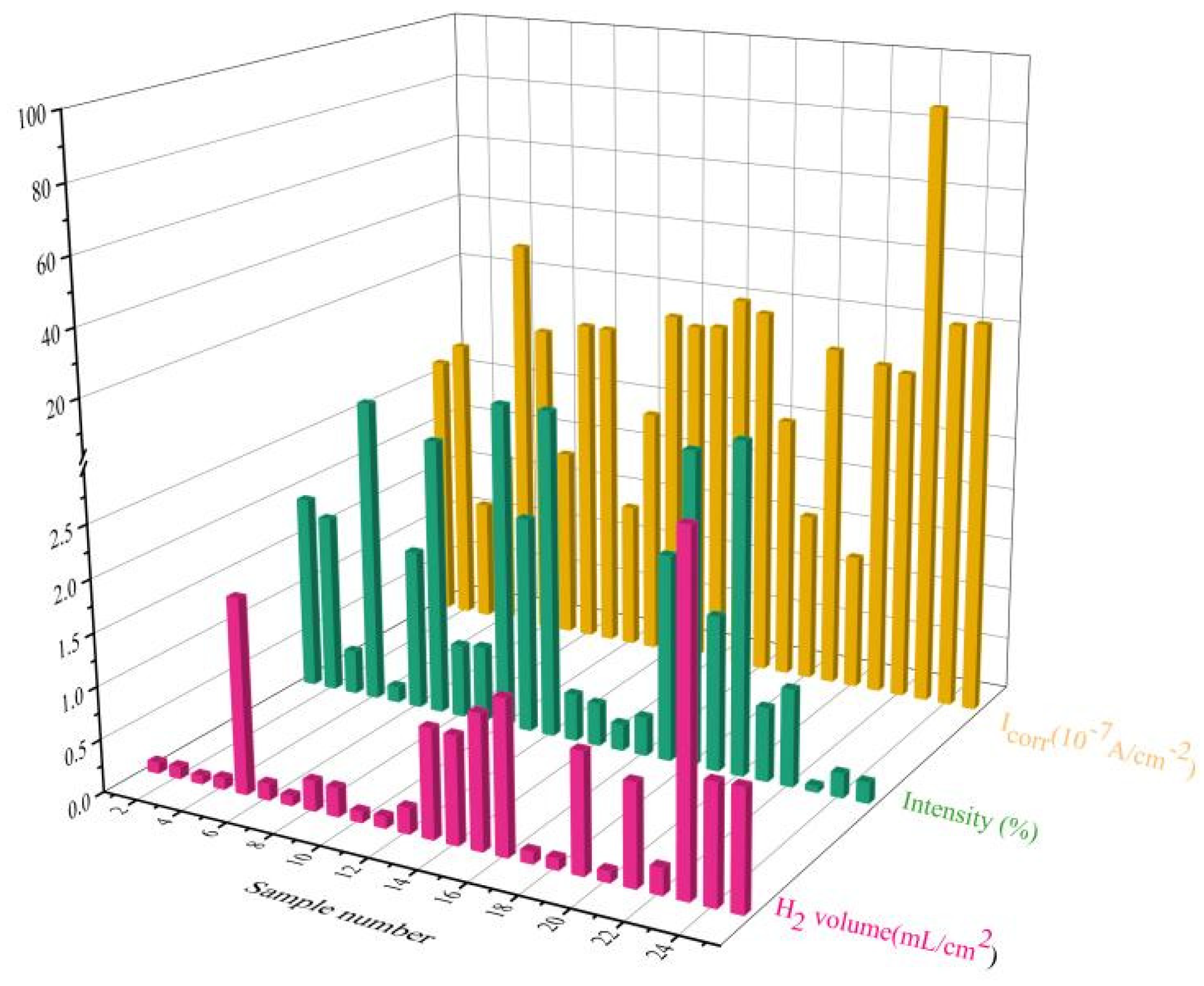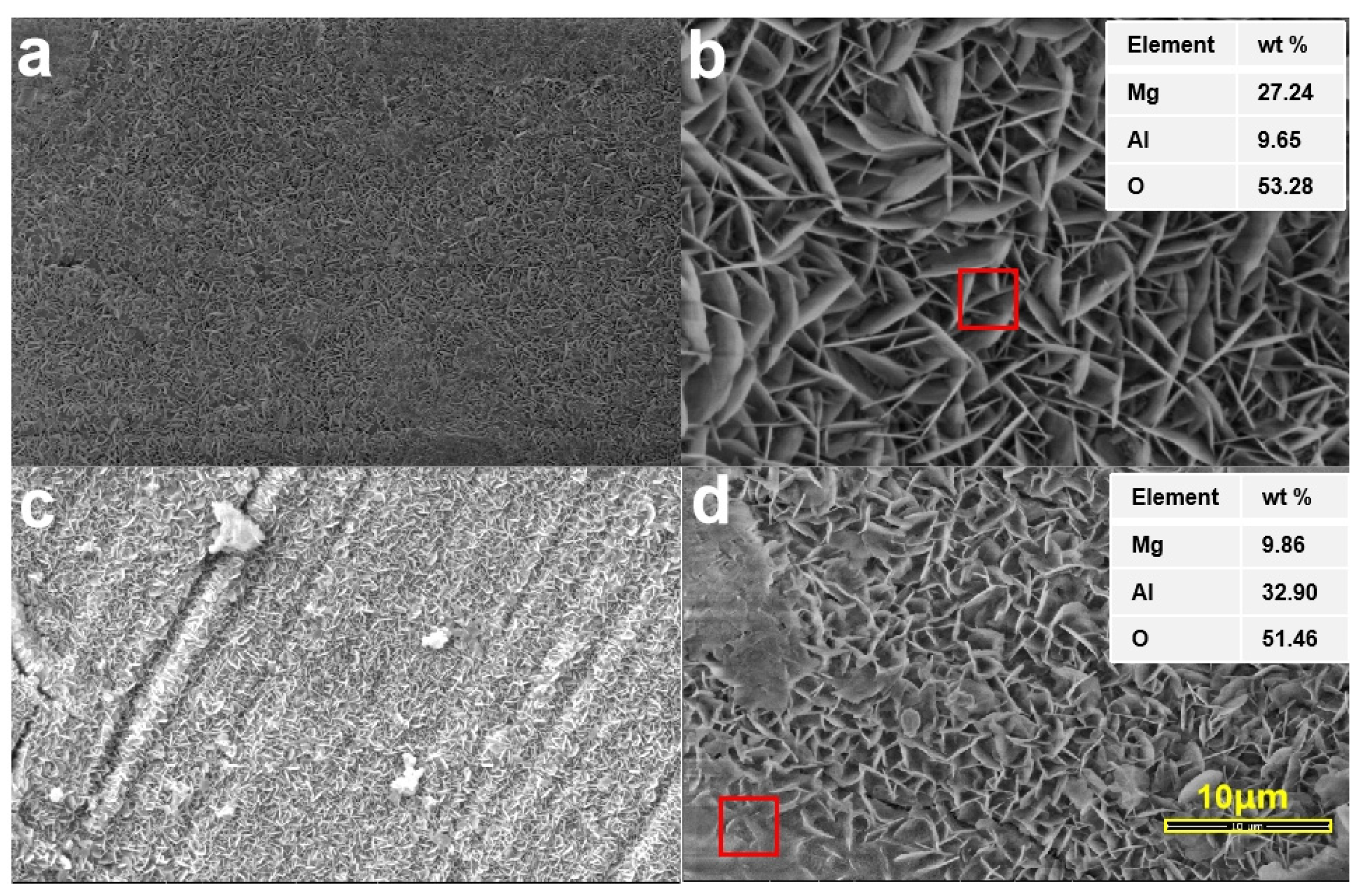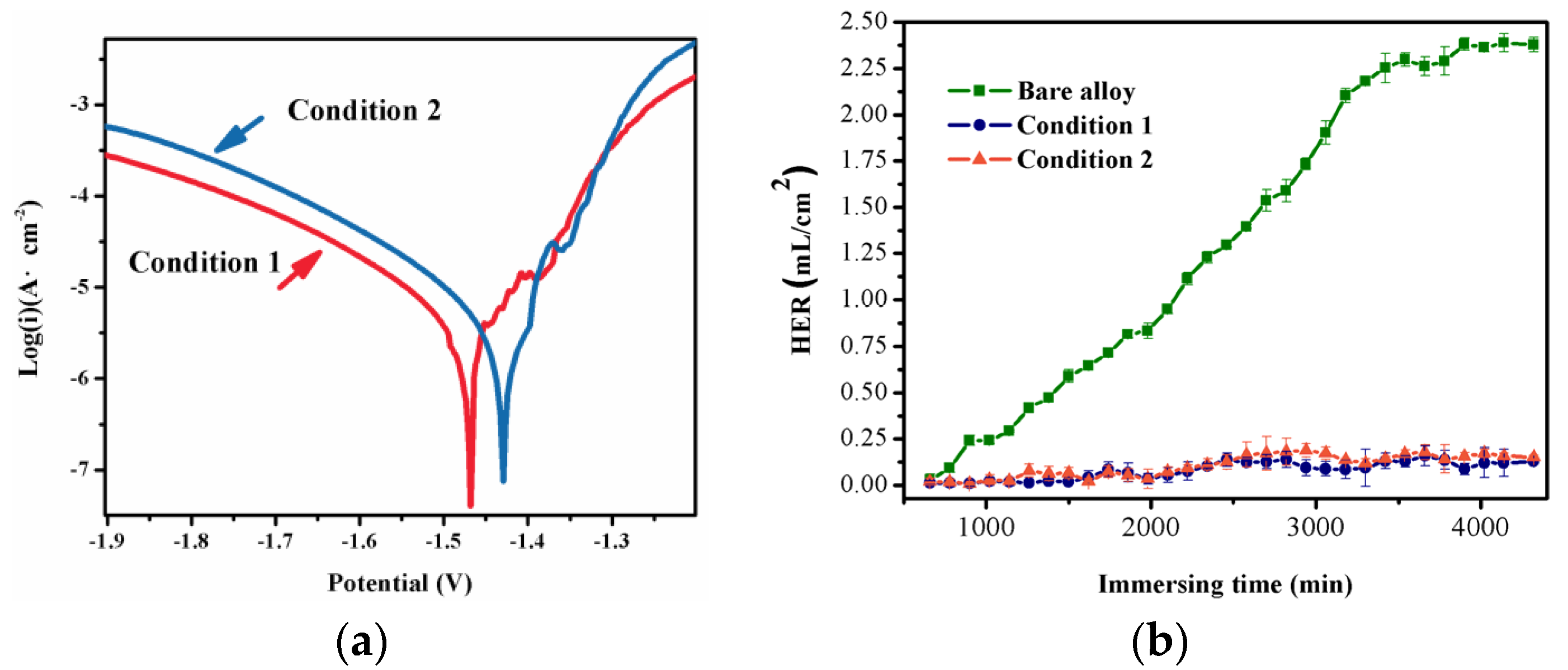The Effects of Reaction Parameters on the Corrosion Resistance of an Mg-Al Hydroxide Coating via in Situ Growth on a Biomedical Magnesium Alloy
Abstract
:1. Introduction
2. Experimental Materials and Methods
2.1. Preparation of the Substrate Material
2.2. Preparation of the LDH Coating
2.3. Microstructure Characterization
2.4. Corrosion Behavior
| Run | Control Factors | Results | |||||
|---|---|---|---|---|---|---|---|
| A: Temperature (°C) | B: pH Value | C: Time (h) | D: Concentration of Al(NO3)3 (mM) | Relative Content of LDH (%) | Icorr × 10−7 (A/cm2) | H2 Volume after 51 h Immersion (mL/cm2) | |
| 1 | 95 | 9 | 8 | 0.01 | 1.875 | 2.635 | 0.104 |
| 2 | 95 | 10 | 10 | 0.1 | 1.725 | 2.839 | 0.111 |
| 3 | 95 | 11 | 12 | 1 | 0.423 | 1.185 | 0.0757 |
| 4 | 95 | 12 | 14 | 10 | 2.932 | 1.725 | 0.106 |
| 5 | 95 | 13 | 16 | 100 | 0.154 | 30.391 | 1.843 |
| 6 | 110 | 9 | 10 | 1 | 1.549 | 3.253 | 0.154 |
| 7 | 110 | 10 | 12 | 10 | 2.667 | 1.873 | 0.0934 |
| 8 | 110 | 11 | 14 | 100 | 0.705 | 7.033 | 0.285 |
| 9 | 110 | 12 | 16 | 0.01 | 0.732 | 6.843 | 0.275 |
| 10 | 110 | 13 | 8 | 0.1 | 3.512 | 1.424 | 0.102 |
| 11 | 120 | 9 | 12 | 100 | 2.067 | 2.419 | 0.109 |
| 12 | 120 | 10 | 14 | 0.01 | 3.800 | 13.836 | 0.244 |
| 13 | 120 | 11 | 16 | 0.1 | 0.449 | 11.462 | 1.024 |
| 14 | 120 | 12 | 8 | 1 | 0.406 | 12.302 | 1.006 |
| 15 | 120 | 13 | 10 | 10 | 0.254 | 21.638 | 1.255 |
| 16 | 130 | 9 | 14 | 0.1 | 0.368 | 18.546 | 1.438 |
| 17 | 130 | 10 | 16 | 1 | 1.959 | 2.552 | 0.113 |
| 18 | 130 | 11 | 8 | 10 | 2.971 | 1.635 | 0.107 |
| 19 | 130 | 12 | 10 | 100 | 1.471 | 9.987 | 1.118 |
| 20 | 130 | 13 | 12 | 0.01 | 3.818 | 1.302 | 0.104 |
| 21 | 150 | 9 | 16 | 10 | 0.700 | 7.218 | 0.947 |
| 22 | 150 | 10 | 8 | 100 | 0.923 | 5.521 | 0.247 |
| 23 | 150 | 11 | 10 | 0.01 | 0.058 | 86.565 | 6.546 |
| 24 | 150 | 12 | 12 | 0.1 | 0.229 | 22.357 | 1.105 |
| 25 | 150 | 13 | 14 | 1 | 0.196 | 23.659 | 1.113 |
| Blank | - | - | - | - | 256.770 | 2.871 | |
2.5. Bonding Strength Test
3. Results
3.1. Analysis of the Range of the Orthogonal Test Results
3.2. Characteristics of the Optimizing Coatings
4. Discussions
5. Conclusions
Author Contributions
Funding
Institutional Review Board Statement
Informed Consent Statement
Data Availability Statement
Conflicts of Interest
References
- Radha, R.; Sreekanth, D. Insight of magnesium alloys and composites for orthopedic implant applications—A review. J. Magnes. Alloy. 2017, 5, 286–312. [Google Scholar] [CrossRef]
- Kazakova, G.; Safronova, T.; Golubchikov, D.; Shevtsova, O.; Rau, J.V. Resorbable Mg2+-Containing Phosphates for Bone Tissue Repair. Materials 2021, 14, 4857. [Google Scholar] [CrossRef]
- Zhou, W.; Yan, J.; Li, Y.; Wang, L.; Jing, L.; Li, M.; Yu, S.; Cheng, Y.; Zheng, Y.J.B.S. Based on the synergistic effect of Mg2+ and antibacterial peptides to improve the corrosion resistance, antibacterial ability and osteogenic activity of magnesium-based degradable metals. J. Biomater. Sci. 2021, 9, 807–825. [Google Scholar] [CrossRef]
- Seitz, J.-M.; Eifler, R.; Bach, F.-W.; Maier, H.J. Magnesium degradation products: Effects on tissue and human metabolism. J. Biomed. Mater. Res. Part A 2013, 102, 3744–3753. [Google Scholar] [CrossRef]
- Heimann, R.B. Magnesium alloys for biomedical application: Advanced corrosion control through surface coating. Surf. Coat. Technol. 2020, 405, 126521. [Google Scholar] [CrossRef]
- Wu, G.; Wang, C.; Sun, M.; Ding, W. Recent developments and applications on high-performance cast magnesium rare-earth alloys. J. Magnes. Alloy. 2020, 9, 1–20. [Google Scholar] [CrossRef]
- Wu, F.; Liang, J.; Peng, Z.; Liu, B. Electrochemical deposition and characterization of Zn-Al layered double hydroxides (LDHs) films on magnesium alloy. Appl. Surf. Sci. 2014, 313, 834–840. [Google Scholar] [CrossRef]
- Zhang, F.; Liu, Z.-G.; Zeng, R.-C.; Li, S.-Q.; Cui, H.-Z.; Song, L.; Han, E.-H. Corrosion resistance of Mg–Al-LDH coating on magnesium alloy AZ31. Surf. Coat. Technol. 2014, 258, 1152–1158. [Google Scholar] [CrossRef]
- Wong, H.M.; Yeung, K.W.K.; Lam, K.O.; Tam, V.; Chu, P.K.; Luk, K.D.K.; Cheung, K.M.C. A biodegradable polymer-based coating to control the performance of magnesium alloy orthopaedic implants. Biomaterials 2010, 31, 2084–2096. [Google Scholar] [CrossRef]
- Li, C.-Y.; Gao, L.; Fan, X.-L.; Zeng, R.-C.; Chen, D.-C.; Zhi, K.-Q. In vitro degradation and cytocompatibility of a low temperature in-situ grown self-healing Mg-Al LDH coating on MAO-coated magnesium alloy AZ31. Bioact. Mater. 2020, 5, 364–376. [Google Scholar] [CrossRef]
- Wu, W.; Wang, Z.; Zang, S.; Yu, X.; Yang, H.; Chang, S. Research Progress on Surface Treatments of Biodegradable Mg Alloys: A Review. ACS Omega 2020, 5, 941–947. [Google Scholar] [CrossRef] [PubMed]
- Mishra, G.; Dash, B.; Pandey, S. Layered double hydroxides: A brief review from fundamentals to application as evolving biomaterials. Appl. Clay Sci. 2018, 153, 172–186. [Google Scholar] [CrossRef]
- Zhang, K.; Xu, Z.P.; Lu, J.; Tang, Z.Y.; Zhao, H.J.; Good, D.A.; Wei, M.Q. Potential for Layered Double Hydroxides-Based, Innovative Drug Delivery Systems. Int. J. Mol. Sci. 2014, 15, 7409–7428. [Google Scholar] [CrossRef]
- Cheng, S.; Zhang, D.; Li, M.; Liu, X.; Zhang, Y.; Qian, S.; Peng, F. Osteogenesis, angiogenesis and immune response of Mg-Al layered double hydroxide coating on pure Mg. Bioact. Mater. 2020, 6, 91–105. [Google Scholar] [CrossRef] [PubMed]
- Tan, J.K.; Balan, P.; Birbilis, N. Advances in LDH coatings on Mg alloys for biomedical applications: A corrosion perspective. Appl. Clay Sci. 2020, 202, 105948. [Google Scholar] [CrossRef]
- Chen, J.; Song, Y.; Shan, D.; Han, E.-H. In situ growth of Mg–Al hydrotalcite conversion film on AZ31 magnesium alloy. Corros. Sci. 2011, 53, 3281–3288. [Google Scholar] [CrossRef]
- Chen, J.; Song, Y.; Shan, D.; Han, E.-H. Study of the in situ growth mechanism of Mg–Al hydrotalcite conversion film on AZ31 magnesium alloy. Corros. Sci. 2012, 63, 148–158. [Google Scholar] [CrossRef]
- Chen, J.; Song, Y.; Shan, D.; Han, E.-H. In Situ Growth Process of Mg–Al Hydrotalcite Conversion Film on AZ31 Mg Alloy. J. Mater. Sci. Technol. 2015, 31, 384–390. [Google Scholar] [CrossRef]
- Wu, L.; Zhang, Z.C.; Pan, F.S.; Tang, A.T.; Zhang, G.; Liu, L. Influence of Reaction Temperature on the Controlled Growth of Mg-Al LDH Film. Int. J. Electrochem. Sci. 2017, 12, 6352–6364. [Google Scholar] [CrossRef]
- Wu, L.; Pan, F.; Liu, Y.; Zhang, G.; Tang, A.; Atrens, A. Influence of pH on the growth behaviour of Mg–Al LDH films. Surf. Eng. 2017, 34, 674–681. [Google Scholar] [CrossRef]
- Reichle, W. Synthesis of anionic clay minerals (mixed metal hydroxides, hydrotalcite). Solid State Ionics 1986, 22, 135–141. [Google Scholar] [CrossRef]
- Costantino, U.; Marmottini, F.; Nocchetti, M.; Vivani, R. New synthetic routes to hydrotalcite-like compounds—Characterisation and properties of the obtained materials. Eur. J. Inorg. Chem. 1998, 1998, 1439–1446. [Google Scholar] [CrossRef]
- Wang, Y.; Li, X.; Chen, M.; Zhao, Y.; You, C.; Li, Y.; Chen, G. In Vitro and in Vivo Degradation Behavior and Biocompatibility Evaluation of Microarc Oxidation-Fluoridated Hydroxyapatite-Coated Mg–Zn–Zr–Sr Alloy for Bone Application. ACS Biomater. Sci. Eng. 2019, 5, 2858–2876. [Google Scholar] [CrossRef]
- Koga, G.Y.; Albert, B.; Roche, V.; Nogueira, R.P. A comparative study of mild steel passivation embedded in Belite-Ye’elimite-Ferrite and Porland cement mortars. Electrochim. Acta 2018, 261, 66–77. [Google Scholar] [CrossRef]
- Zhao, Y.-B.; Liu, H.-P.; Li, C.-Y.; Chen, Y.; Li, S.-Q.; Zeng, R.-C.; Wang, Z.-L. Corrosion resistance and adhesion strength of a spin-assisted layer-by-layer assembled coating on AZ31 magnesium alloy. Appl. Surf. Sci. 2018, 434, 787–795. [Google Scholar] [CrossRef]
- Yu, L.; Zhao, Z.; Tang, C.; Li, W.; You, C.; Chen, M. The mechanical and corrosion resistance of Mg-Zn-Ca-Ag alloys: The influence of Ag content. J. Mater. Res. Technol. 2020, 9, 10863–10875. [Google Scholar] [CrossRef]
- Ishizaki, T.; Kamiyama, N.; Watanabe, K.; Serizawa, A. Corrosion resistance of Mg(OH)2/Mg-Al layered double hydroxide composite film formed directly on combustion-resistant magnesium alloy AMCa602 by steam coating. Corros. Sci. 2015, 92, 76–84. [Google Scholar] [CrossRef]
- Nakamura, K.; Tsunakawa, M.; Shimada, Y.; Serizawa, A.; Ishizaki, T. Formation mechanism of Mg-Al layered double hydroxide-containing magnesium hydroxide films prepared on Ca-added flame-resistant magnesium alloy by steam coating. Surf. Coat. Technol. 2017, 328, 436–443. [Google Scholar] [CrossRef]
- Ishizaki, T.; Chiba, S.; Suzuki, H. In Situ Formation of Anticorrosive Mg-Al Layered Double Hydroxide-Containing Magnesium Hydroxide Film on Magnesium Alloy by Steam Coating. ECS Electrochem. Lett. 2013, 2, C15–C17. [Google Scholar] [CrossRef]
- Zhang, X.H.; Su, G.C.; Han, Y.Y.; Ai, X.H.; Yan, W.L. A study on the composition optimization and mechanical properties of Al-Mg-Si cast alloys. Mater. Sci. Eng. A-Struct. Mater. Prop. Microstruct. Processing 2010, 527, 3852–3856. [Google Scholar] [CrossRef]
- Cui, X.-J.; Lin, X.-Z.; Liu, C.-H.; Yang, R.-S.; Zheng, X.-W.; Gong, M. Fabrication and corrosion resistance of a hydrophobic micro-arc oxidation coating on AZ31 Mg alloy. Corros. Sci. 2015, 90, 402–412. [Google Scholar] [CrossRef]
- Zou, Y.-H.; Wang, J.; Cui, L.-Y.; Zeng, R.-C.; Wang, Q.-Z.; Han, Q.-X.; Qiu, J.; Chen, X.-B.; Chen, D.-C.; Guan, S.-K.; et al. Corrosion resistance and antibacterial activity of zinc-loaded montmorillonite coatings on biodegradable magnesium alloy AZ31. Acta Biomater. 2019, 98, 196–214. [Google Scholar] [CrossRef]
- Chen, Y.; Li, W.; Wang, W.; Zhao, Y.; Chen, M. Microstructure, corrosion resistance, and antibacterial properties of an Ag/Mg-Al layered double hydroxide coating synthesized in situ on biomedical Mg-Zn-Ca alloy. Ceram. Int. 2021, 48, 4172–4187. [Google Scholar] [CrossRef]
- Gou, G.J.; Ma, P.H.; Chu, M.X. Kinetics of synthetic of Cl- type hydrotalcitelike with coprecipitation reaction. Acta Phys. -Chim. Sin. 2004, 20, 1357–1363. [Google Scholar]
- Eliseev, A.; Lukashin, A.; Vertegel, A.; Tarasov, V.; Tret’yakov, Y.D. A Study of Crystallization of Mg–Al Double Hydroxides. In Doklady Chemistry; Kluwer Academic Publishers-Plenum Publishers: Drive Norwell, MA, USA, 2002; pp. 339–343. [Google Scholar]
- Heng-xu, X.; Jun-li, S.; Si-yuan, L.; Li-feng, H.; Hua-yun, D.; Bao-sheng, L.; Ying-hui, W. Effect of hydrothermal reaction temperature on structure and corrosion resistance of CaAl-LDH film on AZ31 magnesium alloy. Chin. J. Nonferrous Met. 2021, 31, 298–309. [Google Scholar]
- Zhiqiang, L.; Libin, Y.; Zuoliang, S.; Yanfei, W.; Liang, Z.; Xiaoyu, Z. Experimental research on growth and crystal size control of potassium chloride in batch cooling crystallization. Inorg. Chem. Ind. 2019, 51, 33–36. [Google Scholar]
- Zhang, G.; Wu, L.; Tang, A.T.; Chen, X.B.; Ma, Y.L.; Long, Y.; Peng, P.; Ding, X.X.; Pan, H.L.; Pan, F.S. Growth behavior of MgAl-layered double hydroxide films by conversion of anodic films on magnesium alloy AZ31 and their corrosion protection. Appl. Surf. Sci. 2018, 456, 419–429. [Google Scholar] [CrossRef]
- Chen, J.; Feng, J.; Yan, L.; Li, H.; Xiong, C.; Ma, S. In situ growth process of Mg–Fe layered double hydroxide conversion film on MgCa alloy. J. Magnes. Alloy. 2020, 9, 1019–1027. [Google Scholar] [CrossRef]








| Design Factors | Unit | Level 1 | Level 2 | Level 3 | Level 4 | Level 5 |
|---|---|---|---|---|---|---|
| A: Temperature | °C | 95 | 110 | 120 | 130 | 150 |
| B: pH Value | - | 9 | 10 | 11 | 12 | 13 |
| C: Time | Hour | 8 | 10 | 12 | 14 | 16 |
| D: Concentration of Al(NO3)3 | mM | 0.01 | 0.1 | 1 | 10 | 100 |
| Prosperity | ||||||||
|---|---|---|---|---|---|---|---|---|
| ILDH(003)/IMg(OH)2(001) (%) | Icorr × 10−6 (A/cm2) | |||||||
| A | B | C | D | A | B | C | D | |
| H1 | 7.109 | 6.191 | 9.686 | 10.283 | 0.702 | 0.817 | 0.526 | 0.486 |
| H2 | 9.165 | 7.934 | 5.057 | 5.914 | 0.545 | 0.635 | 0.972 | 0.845 |
| H3 | 6.975 | 4.606 | 9.202 | 4.533 | 0.724 | 1.075 | 0.583 | 1.103 |
| H4 | 10.220 | 5.769 | 7.633 | 4.528 | 0.425 | 0.893 | 0.655 | 1.104 |
| H5 | 2.104 | 11.073 | 3.993 | 5.320 | 2.375 | 0.452 | 1.256 | 0.939 |
| h1 | 1.422 | 1.548 | 1.937 | 2.057 | 0.140 | 0.163 | 0.105 | 0.097 |
| h2 | 1.833 | 1.587 | 1.011 | 1.479 | 0.109 | 0.127 | 0.194 | 0.169 |
| h3 | 1.395 | 0.921 | 1.841 | 0.937 | 0.145 | 0.215 | 0.117 | 0.221 |
| h4 | 2.555 | 1.154 | 1.908 | 0.942 | 0.085 | 0.179 | 0.131 | 0.221 |
| h5 | 0.421 | 2.215 | 0.799 | 1.064 | 0.475 | 0.090 | 0.251 | 0.188 |
| R | 2.134 | 1.294 | 1.139 | 1.114 | 0.390 | 0.125 | 0.146 | 0.124 |
| Sequence by order of importance | A > B > C > D | A > C > B > D | ||||||
| Optimum composition | A4B5C1D4 (condition 1:130 °C, pH = 13, 8 h, 10 mM) | A4C4B5D4 (condition 2: 130 °C, 14 h, pH = 13, 10 mM) | ||||||
| Sample | −Ecorr (V) | Icorr (μA·cm−2) | βa (mV·dec−1) | βc (mV·dec−1) | Rp (kΩ·cm2) |
|---|---|---|---|---|---|
| Condition 1 | −1.47 | 1.18 | 157 | −107 | 11.76 |
| Condition 2 | −1.42 | 1.21 | 59.8 | −114 | 7.07 |
| Samples | Rs (Ω·cm2) | CPE1 (Ω−1·sn·cm−2) | n1 | R1 (Ω·cm2) | CPE2 (Ω−1·sn·cm−2) | n2 | Rct (Ω·cm2) | RL (Ω·cm2) | L (H·cm−2) | χ2 |
|---|---|---|---|---|---|---|---|---|---|---|
| Condition 1 | 20.35 | 2.215 × 10−6 | 0.3230 | 903.3 | 4.403 × 10−5 | 0.6699 | 1.229 × 104 | 1.616 × 105 | 4134 | 8.737 × 10−3 |
| Condition 2 | 22.18 | 7.702 × 10−5 | 0.4326 | 185.7 | 7.501 × 10−7 | 0.918 | 3207 | 1162 | 858.6 | 4.824 × 10−3 |
| Lc1 | Lc2 | Lc3 | |
|---|---|---|---|
| Load (N) | Load (N) | Load (N) | |
| Condition 1 | 23.6 ± 0.46 | 26.2 ± 0.12 | 27.2 ± 0.11 |
| Condition 1 (*) | 15.0 ± 0.81 | 17.2 ± 0.23 | 19.6 ± 0.17 |
| Condition 2 | 19.6 ± 0.72 | 24.4 ± 0.44 | 26.4 ± 0.32 |
| Condition 2 (*) | 14.2 ± 0.77 | 16.7 ± 0.26 | 17.2 ± 0.25 |
Publisher’s Note: MDPI stays neutral with regard to jurisdictional claims in published maps and institutional affiliations. |
© 2022 by the authors. Licensee MDPI, Basel, Switzerland. This article is an open access article distributed under the terms and conditions of the Creative Commons Attribution (CC BY) license (https://creativecommons.org/licenses/by/4.0/).
Share and Cite
Zhao, Y.; Tian, A.; Wang, W.; Chen, Y.; Li, W.; Liu, W.; Chen, M. The Effects of Reaction Parameters on the Corrosion Resistance of an Mg-Al Hydroxide Coating via in Situ Growth on a Biomedical Magnesium Alloy. Coatings 2022, 12, 1388. https://doi.org/10.3390/coatings12101388
Zhao Y, Tian A, Wang W, Chen Y, Li W, Liu W, Chen M. The Effects of Reaction Parameters on the Corrosion Resistance of an Mg-Al Hydroxide Coating via in Situ Growth on a Biomedical Magnesium Alloy. Coatings. 2022; 12(10):1388. https://doi.org/10.3390/coatings12101388
Chicago/Turabian StyleZhao, Yun, Aixian Tian, Wei Wang, Yangping Chen, Wei Li, Wen Liu, and Minfang Chen. 2022. "The Effects of Reaction Parameters on the Corrosion Resistance of an Mg-Al Hydroxide Coating via in Situ Growth on a Biomedical Magnesium Alloy" Coatings 12, no. 10: 1388. https://doi.org/10.3390/coatings12101388





